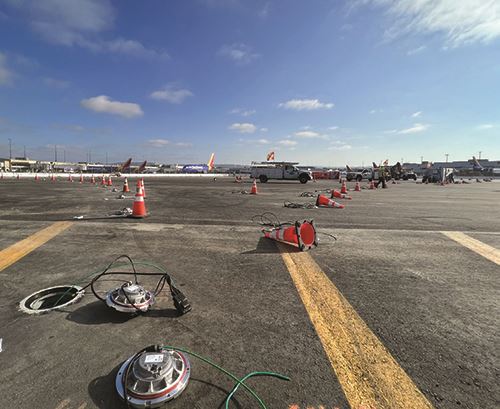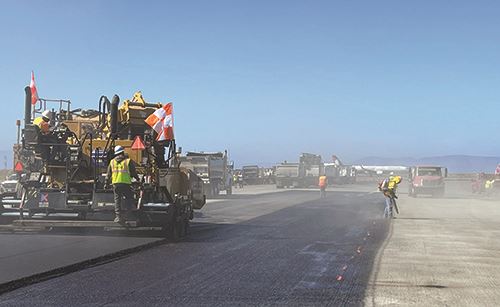Officials at Oakland International Airport (OAK) in California orchestrated a complex, multi-phase rebuild of a critical taxiway that was substantially completed in about 80 days without any disruptions to airline traffic.
Officials at Oakland International Airport (OAK) in California orchestrated a complex, multi-phase rebuild of a critical taxiway that was substantially completed in about 80 days without any disruptions to airline traffic.
The $15.9 million project began in mid-August 2022 and was finished at the end of last October. It required detailed planning and constant communication with various stakeholders because Taxiway T is the only route that connects the terminal complex to OAK’s south field taxiways and its 10,000-foot-long main runway. Typically, the crucial taxiway handles 350 to 400 aircraft operations per day.
In addition, the highly used route provides access to nearly 80% of OAK’s gates—22 out of 29—and Southwest Airlines (the airport’s biggest carrier) uses five overnight parking spots on the other side of the taxiway.
|
Project: Rebuilding Main Taxiway Location: Oakland (CA) Int’l Airport Airport Owner/Operator: Port of Oakland 2022 Passenger Volume: About 11.1 million Taxiway Length: 1,300 ft. Project Cost: $15.9 million Funding: $11.2 million in FAA grants; $4.7 million from Port of Oakland Construction: Aug.-Oct. 2022 Main Components: Geometry upgrades to meet latest FAA criteria; pavement rehabilitation; airfield grading; drainage improvements; new lighting & signage; utility upgrades; new pavement markings Prime Design Consultant: AECOM Prime Contractor: Bay Cities Paving & Grading Inc. Pilot Communication Support: Jeppesen; NAVBLUE Taxiway Lights: ADB Safegate Temporary Taxiway Lights: Avlite Systems Main Challenges: Keeping airport operational during 8 construction phases; maintaining safety/security standards & enabling access to 22 gates accessible only via taxiway being rehabilitated Key Benefits: Meeting current FAA standards; increasing safety with upgraded lighting |
“This taxiway essentially is our Main Street,” explains Dan Pruim, an associate aviation project manager at OAK. “So we had to do the project while maintaining operations on this critical and highly trafficked part of the airfield, while at the same time optimizing safety and security.”
Vince Chu, lead resident engineer for the project, helped navigate the complexities involved. “With this project occurring right in front of the terminal, there was a lot of interface with planes in terms of more striping and electrical work required than usual,” says Chu. “So the phasing was a little trickier than usual.”
Chu is an associate civil engineer for the Port of Oakland, which owns and operates OAK.
Personnel from AECOM, prime design consultant for the Port of Oakland, were also keenly aware of the high stakes involved. “Any aircraft that arrives at OAK has to use Taxiway Tango to get to the terminal, and every departing airplane has to use it to get to the runway,” says Duke Young, an aviation project manager with the company. “So the project involved significant phasing and a lot of collaboration between stakeholders to make it a success.”
Many Upgrades
The asphalt-and-concrete taxiway was last rebuilt in 2007 and had reached the end of its 10- to 15-year lifecycle. The FAA provided roughly $11.2 million in grants to fund the project, with the Port of Oakland paying the remaining $4.7 million.
The project’s main components were taxiway geometry upgrades to the latest FAA design standards, pavement rehabilitation, grading, drainage improvements, new airfield lighting and signage, utility upgrades and new pavement markings.
Rehabilitating the new 1,300-foot-long, 75-foot-wide taxiway required 17,000 tons of asphalt and concrete as well as 18,000 linear feet of new electrical cable to power the lights, plus 55,000 square feet of new pavement markings. ADB Safegate supplied the new airfield LED lights–170 green taxiway centerline lights and 78 blue taxiway edge lights—which replaced former incandescent versions.
Crews deposited approximately 3,800 cubic yards of concrete/asphalt millings in various locations on the airport’s 2,500-acre grounds, primarily for vegetation control along taxiways, shoulders and aprons. Millings that weren’t recycled on airport grounds were used by general contractor Bay Cities Paving & Grading Inc. on another project.
“Basically, all the millings were re-used,” notes Chu.
Lots of Moving Pieces
Various iterations of a temporary taxiway that bypassed the construction site were key to maintaining aircraft operations. However, they required crews to install temporary pavement, signage, edge lighting (150 solar fixtures the airport already owned) and hundreds of feet of security barricades. The barricades were 6-foot-tall, TSA-compliant chain-link fencing mounted atop 2-foot, 8-inch-tall K-rails (concrete barriers) and topped with barbed wire.
 In all, the project included eight phases. The transition to a new taxiway realignment for each phase–which included removing and then re-installing most of the aforementioned items—had to be accomplished from midnight to 5:00 a.m. on Mondays, when the airport has no scheduled flights.
In all, the project included eight phases. The transition to a new taxiway realignment for each phase–which included removing and then re-installing most of the aforementioned items—had to be accomplished from midnight to 5:00 a.m. on Mondays, when the airport has no scheduled flights.
“Planes were ready to leave at 5:01 a.m., and we had to be ready to open,” Pruim recalls. “But we’ve learned from previous projects how to be creative with phasing while maintaining operations and maximizing airfield safety.”
One particular phase was especially challenging because planes had to maneuver through an S-curve-shaped section of temporary taxiway that was only 50 feet wide compared to the airport’s existing 75 feet. It took two weeks to build the bypass, but when the transition to using it occurred, pilots found it difficult to negotiate the double curve, even though it was built to FAA minimum standards.

“Since they weren’t familiar with that kind of configuration, some pilots were hitting the temporary edge lights, which were about a foot high, with the plane tires,” Chu explains. “So we changed the alignment of the lights a bit and added reflective pavement markers on the asphalt for better visibility.
“It didn’t completely eliminate the problem, but it significantly reduced the number of lights that were hit during the two weeks we used that configuration.”
The airport also increased its communications and instructed pilots to reduce speed and closely follow the taxiway’s centerline to avoid the edge lights.

Parts Shortages
COVID-related supply chain issues and parts shortages also posed a challenge, particularly regarding the permanent airfield lighting fixtures. As a workaround, OAK had crews re-install some of the old lights until new ones were available, and also opted for partial shipments of lights instead of waiting for all of them to come in at once.
“Global supply chain problems were an issue, even though we sourced the taxiway lights very early—about six months before construction started—because it’s taking a long time to get the circuit boards needed to fabricate the lights,” explains AECOM’s Young.
Pruim notes that many items were ordered earlier than usual, with about 10% of the design left to complete, to help mitigate supply chain issues.
“While the majority of items arrived by the last phase, approximately 30 airfield LED taxiway edge lights did not arrive until December,” he laments.
Communication Was Critical
Chu and Pruim both emphasize the value of keeping a wide variety of stakeholders informed throughout the project. Important constituents ranged from airlines and cargo operators to air traffic controllers, airport operations personnel and the FAA.
OAK coordinated with Jeppesen and NAVBLUE to create up-to-date aeronautical charts depicting each phase of the taxiway rebuild for pilots, another key stakeholder group, as well as user-friendly graphics for a wide array of ground handlers and ramp side personnel.
“That was a huge component in the project,” Pruim says. “We had to figure out how to best communicate with all stakeholders as we moved through each phase. We also had to realign service roads, so there were a lot of people to keep in the loop.”
Before breaking ground, OAK officials brought in representatives from Bay Cities Paving to walk through the project, phase by phase, with stakeholders. During the meetings, company representatives asked for feedback about what would be important for each party involved.
“Bringing in Bay Cities, which was relatively new to airport projects, was critical to the project’s success,” Pruim says. “It was important to explain how important and impactful this project was and emphasize that our success depended on their success.”
The project also required a lot of preplanning and the development of contingency plans in case things went awry.
“But everything was finished on time and on budget,” Chu proudly reports.
Teamwork Makes the Dream Work
Pruim, Chu and Young agree that teamwork among the project partners helped pave the way for a great outcome.
 “From our perspective, the project was a complete success—on time and on budget,” Young says. “It was a total team effort. Between all the different transitions and phases, things had to go seamlessly…and I think the general contractor did a great job of working with us and was very open to feedback about how to minimize any impacts.”
“From our perspective, the project was a complete success—on time and on budget,” Young says. “It was a total team effort. Between all the different transitions and phases, things had to go seamlessly…and I think the general contractor did a great job of working with us and was very open to feedback about how to minimize any impacts.”
“We had a good team in place,” adds Chu, “with a lot of collaboration between engineering, the prime contractor, operations, planning, security, airlines and other various stakeholders.”
Pruim notes that there was a lot at stake, but teamwork won the day.
“Our goal was to upgrade this taxiway to the latest FAA standards,” he says. “It was very important to get it right the first time because this was such a high-impact and time-sensitive project.”
“And that’s exactly what we achieved,” Pruim continues. “Our Main Street remained open throughout the entire project.”


 facts&figures
facts&figures

